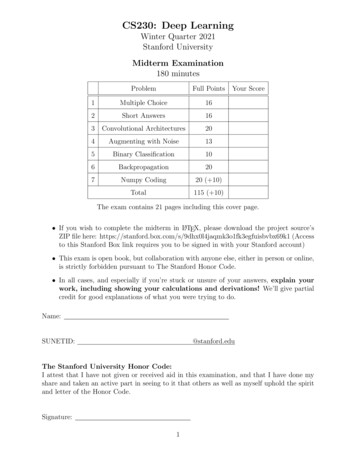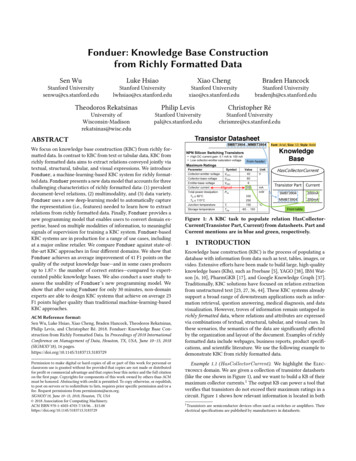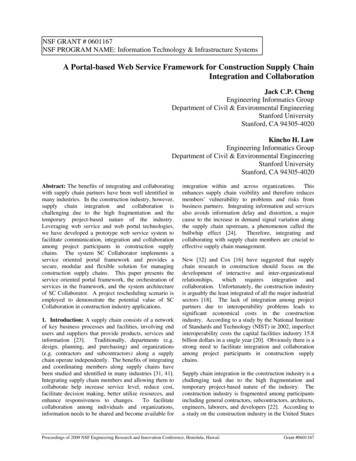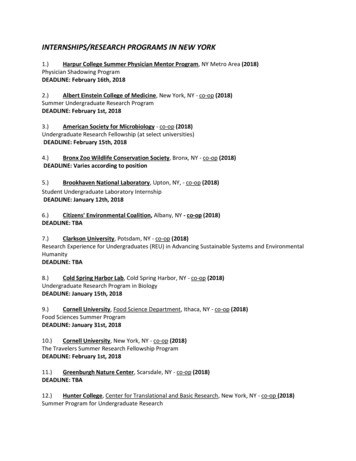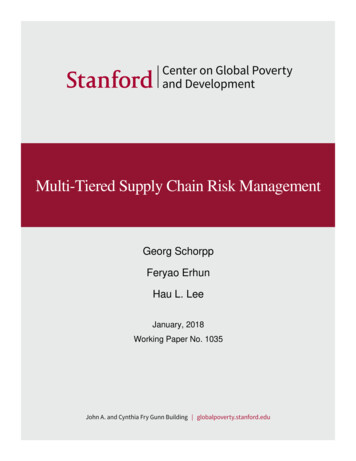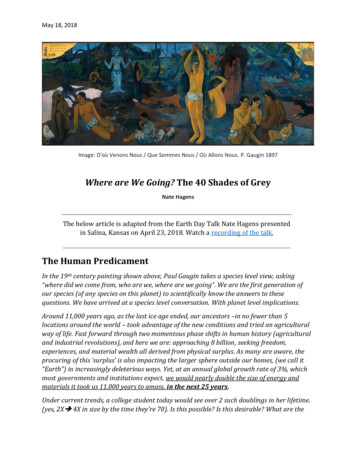
Transcription
May 18, 2018Image: D'où Venons Nous / Que Sommes Nous / Où Allons Nous. P. Gaugin 1897Where are We Going? The 40 Shades of GreyNate HagensThe below article is adapted from the Earth Day Talk Nate Hagens presentedin Salina, Kansas on April 23, 2018. Watch a recording of the talk.The Human PredicamentIn the 19th century painting shown above, Paul Gaugin takes a species level view, asking“where did we come from, who are we, where are we going”. We are the first generation ofour species (of any species on this planet) to scientifically know the answers to thesequestions. We have arrived at a species level conversation. With planet level implications.Around 11,000 years ago, as the last ice age ended, our ancestors –in no fewer than 5locations around the world – took advantage of the new conditions and tried an agriculturalway of life. Fast forward through two momentous phase shifts in human history (agriculturaland industrial revolutions), and here we are: approaching 8 billion, seeking freedom,experiences, and material wealth all derived from physical surplus. As many are aware, theprocuring of this ‘surplus’ is also impacting the larger sphere outside our homes, (we call it“Earth”) in increasingly deleterious ways. Yet, at an annual global growth rate of 3%, whichmost governments and institutions expect, we would nearly double the size of energy andmaterials it took us 11,000 years to amass, in the next 25 years.Under current trends, a college student today would see over 2 such doublings in her lifetime.(yes, 2X 4X in size by the time they’re 70). Is this possible? Is this desirable? What are the
variables that will influence this trajectory? What would be the impacts if it happens? And theimpacts if it doesn’t?If you ask a hundred experts to opine on these issues you’ll get at least a hundred answers,because while economy is composed of systems, it is not explained using systems but by simple,(usually popular) narratives. But only a synthesis integrating aspects of energy, theenvironment, the economy and particularly human behavior will inform what is unlikely,what is possible, what’s at stake, and ultimately what to strive for and work towards.Below is a condensation of many of the big themes relevant to coming decades of the humanenterprise. Despite our desire for simple, clear-cut answers, most of the central issues bearingon our situation do not neatly fall into ‘black or white’ binaries– but lie in the liminal spacebetween. On some of the “40 shades of grey” spectrums presented below, our institutions andsocietal plans are currently far from our biophysical reality– suggesting tectonic culturalshifts are now likely on the near to intermediate term horizon. (NB: this is the horizontal story– there is ‘vertical’ depth available on each of these points).Energy/EconomyEnergy vs Everything Else – Human wealth and productivity is commonly attributedto our own cleverness (technology), existing wealth (capital) and hard work (labor). Theseinputs are important but in turn are all dependent – on energy. Modern economies eatpower like animals eat food – every object and service in human economies first requiresan energy input to convert it into something useful. Ergo, 1 of petroleum has orders ofmagnitude more value than 1 worth of pencils, paperclips or pastries. But energy, otherthan perhaps its dollar cost, is invisible to our society.Flows vs Stocks – The human economy runs on natural resources like copper, iron andphosphorous. Globally 1 of GDP results in 1KG of extracted minerals, energy andmaterials. We are particularly dependent on high density energy resources like oil andnatural gas and from a long term perspective we are living during what might be called ‘theCarbon Pulse’ –a one-time bolus of fossil productivity injected into the human ecosystem.Ninety-eight percent of physical labor in the modern world is done by machines, which inturn are 85% powered by energy-dense carbon compounds. Few think about it, but 1barrel of crude oil, at 5.8 million BTUs (British Thermal Units), for which we currently pay 70, contains the work equivalent of 4.5 years of human labor, for which we pay (in theUSA) 140,000. The average American uses 54 of these ‘barrels’ per year directly, with anadditional 10-20 via imported goods, equating to 300 ‘fossil slaves’ supporting ourlifestyles. In effect, though we eat 2,500 calories via food, we each ‘consume’ over 200,000calories per day overall. Our culture effectively treats all these geological inputs as ‘flows’(like rivers, rain, sunlight, tree growth) but they are depletable stocks. No natural resourcestocks are renewable on human time scales. Drilling holes is not sustainable. Our culturalstories conflate stocks with flows.
Stocks vs Abstractions –Stocks (oil, copper, phosphorous) typically follow predictable(gaussian) curves that rise, peak and decline. The amount of these ‘stocks’ we access hasgenerally been increasing for over a century but has now started to decline in many cases(oil quality, iron ore grade, copper overburden, etc.). But our supply of money and creditcontinues to increase with no reference to the area of the curve remaining for these onetime natural stock endowments. (Globally it took over 4 of new debt to add 1 ofadditional GDP in 2017). We can print money, but we cannot print energy, only extract itfaster with borrowed money.Gross vs Net – We commonly count on the absolute amount of a resource, stock orreservoir available without considering the amount of it that can be technically oreconomically extracted. As we access the deeper, harder to find and more environmentallydamaging resources, we spend an increasing amount of the key resources to get at the keyresources. (E.g. static field decline for US shale oil is 30-40% per year, so production willnow largely be a function of how many new wells are drilled). We have now left the erawhere our culture spent 5% of our energy on finding and delivering energy, to one wherewe will be spending 10% or even 15% to 20%. This all manifests in higher costs andlower benefits for people and economies. As more energy is redirected to the energy sector,which sectors will get less/none? The net is ultimately what we are able to spend.Joules vs Work –Energy can only be substituted by other energy. Conventionaleconomic thinking on most depletable resources considers substitution possibilities asessentially infinite. But not all joules perform equally. There is a large difference betweenpotential and kinetic energy. Energy properties such as: intermittence, variability, energydensity, power density, spatial distribution, energy return on energy invested, scalability,transportability, etc. make energy substitution a complex prospect. The ability of atechnology to provide ‘joules’ is different than its ability to contribute to ‘work’ for society.All joules do not contribute equally to human economies.Economy vs Economics – The modern human ecosystem can be simply described. Weuse technology to convert energy and materials into products measured in dollars. We turnthe dollars/products into neurotransmitters (feelings) waste/impact. Repeat at larger scale.We often mistake a trend for a reality and a short-term pattern for an axiom of nature. In amodern (and relevant) case, we have constructed rules and ‘economic laws’ around a longby-human-lifespan, but short-by-human-history unique period of time during which,because of one-time inputs on geologic time scales, we’ve experienced continual economicgrowth for over a century. The constant growth we’ve experienced was correlated withhuman inventions and economic theories, but the cause was finding a bolus of fossilsunlight. We behave like squirrels living in a forest where a truck full of hazelnuts crashed,living off the freight and thinking it will last forever. Economic theories have –until recently–been right about describing our trajectory but for the wrong reasons –they largely ignore thephysical and biological underpinnings of the human endeavor and will have to be reworked.
BehavioralHuman vs Animal – Humans are clever, unique, adaptable and very capable. Yes, weare special, but we are part of the animal kingdom –part of the mammal and ape lineage.Our behavioral repertoire is amazing, yet still constrained and informed by our heritage.Proximate vs Ultimate – Why do we want that job? Why do we waste time onFacebook? Why do we love stock market returns? Why do we dislike that person? Why dowe want to play with puppies? Why do we go to war? There are proximate – or ‘surface’explanations for all these behaviors, but there are also ‘ultimate’ explanations based on ourancestral past. These ‘ultimate’ explanations can predict and make sense of much ofmodern human behavior. Ultimately, we go through our daily lives seeking ‘brain services’– activities, experiences and behaviors in the modern world that provide the same ‘feelings’that our successful ancestors got in a different environment.Beliefs vs Facts – The human brain can imagine and speak many more wordcombinations representing reality than exist in reality. As such the virtual world in ourminds seems more real to us even in the face of science, logic and common sense. And sincewe construct our own individual virtual worlds, we prefer them over the virtual worlds inothers’ minds. Which is why ‘beliefs’ are far more powerful than facts. Beliefs usuallyprecede the reasons used to explain them. Which is why fake news works and why we findit extremely difficult to convince people about climate change, energy descent, the limits oftechnology, etc.Now vs Future – We are biological creatures with finite lifespans. For good evolutionaryreasons we disproportionately care about the present more than the future. But most ofour modern challenges are ‘in the future’.Supernormal vs Normal – Modern technology provides stimuli orders of magnitudehigher than our ancestors seeking similar feelings experienced. For them, a berry found ontheir path was a rare sweet surprise, while we buy sweets by the pound at the grocerystore, or shipped via Amazon. We can easily become hijacked/addicted to things that ‘feel’important but are just ephemeral action-potentials in the brain, not in the real world.Relative vs Absolute – Fitness in nature is correlated with caloric intake per unit ofeffort. We each follow this simple ‘foraging algorithm’, mediated by the neurotransmitterdopamine, to get more for less. But after basic needs are met, this algorithm shifts to caringsignificantly more about our comparative performance, income, status, ranking vs othersthan we do about absolute measures of the same. Ergo we don’t care about good or bad somuch as better or worse (than our neighbors, or relative to the day before).Wants vs Haves – Our impulses to want something – a pair of shoes, a new car, a toy –feel more intense to us than the satisfaction we get from the possessing of that thing onongoing basis. Which is why our basements and storage units are full of the ghosts of
dopamine past. While our physical world is based on stocks, our brain and behavior isbased on flows, which need to be continually experienced each and every day.Wants vs Needs –Once our basic needs (food, water, basic services, social respect) aremet, we get very little additional life satisfaction from increased consumption. The bestthings in life are free, but ‘yearning’ is a strong human driver.Me vs Us –We are a biological species, and as such on the spectrum of competition vscooperation, we are generally looking out for #1 – ourselves and our family–relative toothers.Us vs Them – But our formative years (millennia actually) were in small nomadic tribeson the African savannah. The success of our tribe –in hunting, resource acquisition, anddefense against other tribes, dictated – and often trumped – our own individual success.This intense favoring of ingroups and ostracizing of outgroups – be they different religions,different political groups, different sports teams or even just different opinions about thefuture – remains with us today.Genes vs Culture – Human nature does not change in the short term– our great-great grandchildren living in 200 years will be subject to all the same drives and constraints I justmentioned. But culture can manifest emergent behaviors –both positive and negative – thatcan happen on much shorter timelines, even less than a decade in some cases. Our genestell us what we need, but culture dictates how we get it. We can get at least a good portionof ‘what we want and need’ using less stuff with less damage.EnvironmentalInternal vs External – In the modern formulation of the market system, we internalizeprofits and externalize costs. The costs –of pollution and negative social impacts– are bornby the commons and the public, which includes other generations and other species. Noindustry in the world would be profitable if full cost pricing were to include all externalizedcosts (e.g. damaging impacts of coal 0.38 kWh full cost instead of 0.04). But most otherspecies don’t care at all about externalities, and as we become socially aware of ourdownstream effects, we have done more to respond to the costs. Relevant examples includeDDT, chlorofluorocarbons, polluted rivers, and unleaded gasoline. But CO2 remains animpact that can’t easily be ‘internalized’.Treasure vs Riches – The vast ecological riches of our natural world: mineral deposits,millions of species, vibrant ecosystems, lush rainforests, etc. are only counted as havingvalue to human economies once they are converted. In our quest for treasure, we haveplundered our riches, and the default plan is to continue to.Civilization vs Community – Humans now appropriate between 30-40% of theannual productivity from sunlight interacting with soil/land on our planet. Additionally, we
(and our cows, pigs, goats, dogs, sheep, etc.) outweigh the sum total of all other terrestrialvertebrates by a ratio of over 50:1. The continuum between human civilization and Earthcommunity – at least so far – has been solely headed in one direction.Seen vs Unseen – Many of the ‘externalities’ of human commerce we can only readabout. Today looks very similar to yesterday. Yet, France (and other countries) has lost 1/3of its bird population in the last 15 years across the board due to fewer insects(presumably due to pesticides), sea creatures 10 km-deep are found to have more toxicchemical concentration than in polluted Chinese rivers, we have lost 50% of animalpopulations since the 1970s, etc. Human sperm count among people in developed countrieshas dropped 50% in past generation. The ocean has lost 2% of its oxygen in the last 50years, etc. We focus (naturally) on the seen – but the unseen currently tells a worryingstory.(The preceding 21 points can be (and will be in an interactive website) supported bymodern science. The points below are logical implications from the above synthesis,but as presented are more my own conclusions.CulturalGame vs Plan–In modern human culture we cooperate at various scales (individuals,corporations, nations) to maximize representations of surplus (monetary profits). Once weunderstand that 1) all goods and services leading to economic output first require aprimary resource conversion, 2) GDP is highly correlated with energy, and 3) to provide‘brain services’ to as many people as possible, governments and institutions do whateverthey can to keep access to energy growing (credit creation, rule changes, guarantees, etc.)the common economic statistic Gross Domestic Product takes on a different connotation. Toa reasonable approximation, GDP could be renamed as GDB – Gross Domestic Burning, asunderpinning every economic transaction a small fire happened somewhere on Earth.From a birds-eye view, modern human society is thus functioning akin to an energydissipating structure. With a collective focus on short term profits, we tacitly assume thebest futures will naturally arrive. But viewed from a perspective of GDB, the market itselfcannot use intelligent foresight. It can only march forward, 3 months at a time. The game –at least so far – is also the plan.Narrow vs Wide – Each issue we encounter has different correct answers depending onhow wide a perspective is used. We can look at the impact of a policy on the taxi driver, onthe taxi company, on the New York City transport system, on New York City itself, on theUSA, on the world today, on future generations, on ecosystems, etc. Most currentpredicaments are viewed from a wider boundary perspective, but most cultural decisionsare made using narrow boundaries.Finance vs Natural Science – In the 20th century we constructed societalinfrastructure and expectations on rules from finance and economics, but the rules from
natural sciences and ecology: primary productivity, trophic cascades, carrying capacity,overshoot, bottlenecks, phase shifts, succession, pulses, etc. are going to be much morepertinent in the 21st.Unlimited vs Limits – Imagine a world with 7.6 billion humans and no laws. No speedlimits, no taxes for public infrastructure, no rules, no courts of law. Humans instinctuallyhave problems to self-impose limits. So, via social contracts and reciprocity, we havelearned to recognize the importance of such institutions, and as a result, society is betteroff. Though we have recognized the importance of rules and constraint on personalbehavior and impact, we have not yet matured to recognize limits for society and culture atlarge. But we live on a finite planet.War vs Peace – Historically in times of fewer resources per capita, earlier humansocieties (and tribes before them) went to war. But this continuum is so often avoided indiscussions that it needs to be mentioned. We will go to war again if we don't manage tocooperate to solve the future constraints in a constructive way, and there are ways. Thistime, war would be much more devastating than ever before in human history. We havehad anti-war movements in the past and hopefully will again in the future – what % of our‘carbon windfall’ is directed to military spending? In a peaceful world where might it betterbe directed?Population vs Consumption – We are 7.6 billion en route to 9-10 billion. UN (andother international institutions) misunderstand the energy primacy underlying humaneconomies. Does a carbon pulse informed synthesis imply substantially lower populationsthis century? No. Unless some of the 4 Horsemen of the Apocalypse show up, by far themore likely scenario is a maintained high population level, with less resources per capita(maybe considerably less). Malthus was "right" but missed the 'vertical revolution' of fossilcarbon. Ehrlich was "right" but missed globalization and the birth of credit markets, pullingresources forward in time. Perhaps someone today hearing this story immediatelyexpecting large population die-offs based on resource constraints will also be “right” butmiss the more obvious trajectory of consumption decline rather than population decline. Inthe developed world, where people consume 50-100x their food consumption for otherthings, there is a lot of room to go down without affecting wellbeing. So less consumption isstill viable, and even desirable. With 350,000 new babies born each day globally but350,000 people/families per day also entering the global middle class, with 5:1 higherthroughput than the average, the ‘population’ issue takes on a different flavor.Intelligence vs Wisdom –Human history is replete with quite intelligent andotherwise successful cultures that simply got something about the big picture cruciallywrong. Easter Islanders believed that resources flowed from the good will of theirancestors, so it was only logical to cut down all the trees to aid in the construction of everbigger stone heads. Their behavior was clever but not wise. Our culture similarly rewardsreductionist viewpoints and expertise in solving problems. But as we increasingly rewardvertical expertise within a discipline, we lose the wisdom that comes from crossingdisciplines. Simply put, intelligence and wisdom work best in synergy. Modern humans,
with ample intelligence but a dearth of wisdom risk becoming idiot-savants, metaphoricallypushing levers in increasingly clever ways, for building modern versions of the stone headson Rapa Nui.Trivia vs Relevance – Our education system is becoming less relevant for the futurewe are facing. Primary and secondary education are a product of energy surplus.Paradoxically, they also are one of the few investments that can contribute to ‘futuresurplus’. Education from a lens of intelligent foresight would focus on science synthesis,understanding our own minds, on ecological principles, dealing with uncertainty, and onthe problem-solving skills that will be increasingly needed in a lower-energy-throughputsociety. Less specialization and more systemic understanding would be the order of thepresent day.Dollars vs Humanity –Of all the supernormal stimuli in modern culture: social media,twitter, Overwatch, slot machines and meat lovers pizza, perhaps the largest and mostpernicious is ‘dollars’. We have managed to parse the entire inventory of what made usfunction in tribal conditions over tens of thousands of decades into one variable:digital/linen markers of status and success. We certainly need currency for transacting andstoring wealth, but our culture has taken it to an extreme, gradually but almost completelyfinancializing the human experience. One can hope that a vast pool of expressions ofhumanity lies dormant beneath the stacks of electronic digits.Good vs Evil – Humans are not evil, not any more than wolves or wildebeest. However,at 8 billion strong, pursuing surplus correlated with finite source and sink capacity, ouractions have ‘evil outcomes’. It is important to not conflate our collective impact with whowe are as individual life forms. What is happening is no one’s fault, but we are all complicit.Should vs Will– Many people are promoting campaigns for what our society ‘should’ doto solve our myriad of economic and environmental problems. But most of these recipes, –with albeit laudable goals – are either incompatible with our physical reality or withbehavioral patterns evolved over hundreds of thousands of years. Banking on ‘suddeninsight’ into the greater good by a majority of people is something environmental activistshave done since the 1960s, and climate activists for almost 2 decades, yet we’re stillemitting more CO2 every year. It is unlikely we will en masse prepare for the GreatSimplification ahead –the cultural, behavioral and systemic barriers are too large. Relativeto planned “change”, we will instead “react and respond”. Instead of advocating forunrealistic outcomes, we can put effort towards changing the initial conditions that willresult in better outcomes and then make new moves – currently not on the gameboard,possible.Popular vs Realistic – Similarly, a full accounting of the severity of our predicament –on radio, television and in papers, will never be popular. It’s much more comfortable (andprofitable) to be entertained, marketed and promised various contrived solutions, usuallywith some unproven or physically unscalable technology, or based on hard-to-detect
fantasy ignoring natural science. We should recognize that glib solutions, typically aren’tsolutions. But acknowledging that would be distressing, and unpopular.Left vs Right – Other than perhaps climate change, both Democrats and Republicans areboth sharply divorced from the realities of our coming challenges. Resource depletion,credit overshoot and the accompanying systemic risks are absent from any politicalconversations. Instead, substantial energy (and vitriol) are expended on the things anincreasing polarized society disagrees on. We will one day soon appreciate (and hopefullyengage with) the issues that most of us agree on: basic needs, family/friends, healthy food,peace, respect, meaning, and a safe and clean environment for our grandchildren to growup in. As such the current arguments between Republicans and Democrats are akin toarguing about which mosquito repellent is best to put on our arms, while a crocodile hasour leg in its mouth.Masculine vs Feminine – We live in a male dominated culture. As a result, amongother things, testosterone and dopamine probably influence decisions more than oxytocinand serotonin. Women –for obvious biological reasons – tend to have shallower discountrates than men (things in the future carry more weight). Given that most of our societalrisks are not this quarter or this year, but in the future, perhaps we shouldencourage/support/mandate a higher percent of leaders and decision makers dealing withlarger scale cultural issues with future outcomes be women. I don’t know how (but I’mmale).Small Groups vs Large Groups –Humans join forces to cooperate on simple andclear pursuits like profits or military defense. But, counterintuitively, intelligence and theability to be creative with reference to complex issues doesn’t increase with group size. Asgroups become larger they become less and less able to grasp and convey complexsituations, let alone creatively respond to them. At the scale of hundreds or thousands in agroup or organization, the resulting behavior defaults to popular and simple responses.(Think of any large environmental or social NGO). This has large implications for thecurrent plethora of risks we face. Forming movements with a lot of people caring about thesame thing is a good idea. But when it comes to getting things done –especially things thatare complex, nuanced, and perhaps unpopular, individuals and small groups have far morepower than they ‘feel’ they do to influence events.Economy vs Environment –If you could create a list of the 10 best ways to improvethe environment, (e.g. carbon tax, protecting international fishing zones, driving curfews,etc.) it would be likely all 10 would be bad for economic growth. Similarly, a list of 10 bestways to grow the economy (e.g. baby subsidy, tax rebate) would all likely make either themicro or macro environmental situation worse. This century, we are going to perpetuallymake decisions (or not make decisions, just act) on a spectrum between what’s best foreconomic growth, and what’s best for planetary ecosystems and our long-term wellbeing.It’s probably good to realize (and care about) this upfront.
Rights vs Responsibilities – There have been many social contracts in recordedhuman history. From the Code of Hammurabi 3500 years ago to the Magna Carta and U.S.Constitution, humans have often created rules and guidelines to properly delineate theneeds and circumstances of the time. We now live on an ecologically full planet – and areaware of what we are, where we came from, what we need, what we want and what we aredoing –to each other and to our surroundings. With this backdrop there is a distinctionbetween ‘rights’ and ‘responsibilities’. This continuum will remain a back-burner item.Until it moves to the front burner.IndividualCertainty vs Probability –The future exists as a probability distribution of very bad,bad, so-so, benign and very good futures. But people dislike uncertainty. When we hearabout the these energy and environmental scenarios we typically either a) reject or denythe implications using rationalizations along the lines of ‘technology will solve it’ / ‘we’llthink of something’ etc. or b) ‘it’s too late – there’s nothing we can do – might as well enjoythe day’. These reactions seem the opposite on the surface but have two things in common:1) they create dissonance resolving ‘certainty’ in our minds and in turn, 2) they obviate theneed for personal response and engagement (which would be uncomfortable emotionallyand physically). The reality is that the future is not yet determined and exists as aconstantly shifting probability distribution based on events, technology, wisdom, risk andthe actions of individuals and communities. We need more people to avoid the two poles ofdenial and nihilism and stay in the center, own a bit of dissonance, and engage.Less vs More –We have financialized the human experience, parsing everything ofsubstance, depth and meaning from our tribal past into electronic/linen markers. Once ourbasic needs are met we don’t really want more, we just want more than the guy/gal nextdoor. We are now likely headed for a world with less physical throughput whether wechoose it or not. But this does not mean we have a world of ‘less’ experiences, happiness,meaning and good lives. The average Guatemalan makes under 10,000 per year but haslife satisfaction and quality the same as countries with 5-10 times as much income.Americans use 38 times the energy as people in the Philippines but are equally happy onwell-being metrics. Americans are far ‘richer’ in material terms than we were 50 years ago,but are less satisfied/content. Less and more need to be unpacked beyond their monetarylabels and the gut reaction to hearing them. As individuals we can strive to be happier withabsolute wealth and focus less on relative. (this takes training and effort)Crazy vs Sane – At 50 times the income of humans 200 years ago, it is no wonder theaverage American is so distracted by convenience and lulled by false narratives as to beasleep to the real issues. People aren’t idiots nor are (most of them) liars. But we are sooften seduced and misinformed by simple narratives that those warning about theconverging macro crises are generally considered crazy by the mainstream. But to be‘woke’ to the issues of the day is perhaps the only route for sanity. Owning a bit of grief and
dissonance about what’s happening is eminently rational, even if it feels bad at times. Ifworrying about the 6th mass extinction, energy descent, limits to growth and the comingGreat Simplification makes one crazy, well perhaps the world needs a who
The 40 Shades of Grey Nate Hagens The below article is adapted from the Earth Day Talk Nate Hagens presented in Salina, Kansas on April 23, 2018. Watch a recording of the talk. The Human Predicament In the 19th century painting shown above, Paul Gaugin takes a species level view, asking





